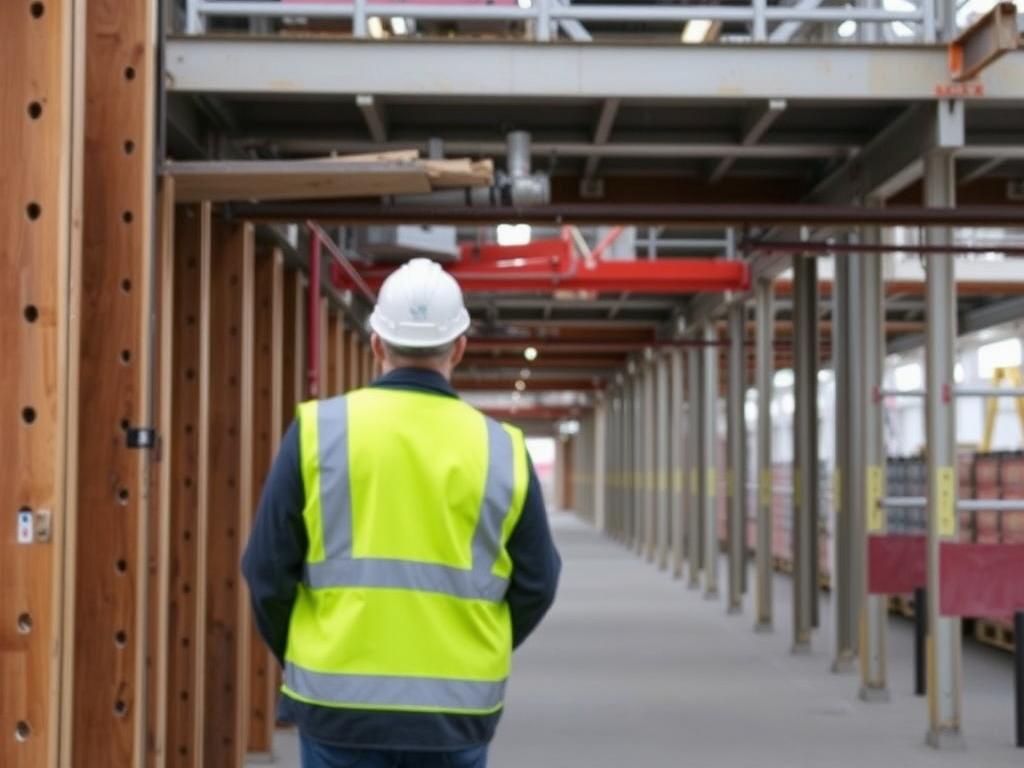Construction sites in Canadian cities are bustling hubs of activity, but unfortunately, they are also prime targets for theft and vandalism. From expensive equipment to materials piled high, the sheer value on any given site makes it an attractive prospect for criminals. Preventing theft in these urban environments requires a strategic approach tailored to the unique challenges faced by construction managers and security professionals. In this article, we’ll explore various methods and best practices to safeguard construction sites, analyzing what works best to reduce losses and enhance overall security.
Understanding the Risks: Why Construction Sites Are Vulnerable

Before diving into solutions, it’s essential to understand why construction sites in Canadian cities are particularly vulnerable to theft. Firstly, many sites are located in easily accessible urban areas, often close to public streets or alleys. This accessibility, combined with the presence of valuable equipment such as excavators, generators, and power tools, makes them attractive targets. Additionally, construction sites often have periods of inactivity – nights, weekends, or during weather delays – when monitoring is lax or absent, creating windows of opportunity for thieves.
Another risk factor is the transient workforce. Many workers cycle in and out quickly, and keeping track of personnel access permissions can be challenging. Furthermore, the nature of construction means materials like copper wiring, piping, and scaffolding are often left exposed, making them vulnerable to theft. Theft at construction sites is not just a loss of property; it leads to project delays, increased insurance premiums, and safety hazards.
Common Types of Theft on Construction Sites
Identifying the types of theft that commonly occur helps in tailoring the security approach. Here’s a breakdown:
- Equipment Theft: Heavy machinery, power tools, and electronic devices are often stolen due to their high value and resale potential.
- Material Theft: Copper wires, steel beams, lumber, and other building materials are attractive to thieves, especially when left unsecured.
- Fuel Theft: Construction vehicles and generators require fuel, which is often targeted by criminals.
- Vandalism and Sabotage: Sometimes theft is accompanied by vandalism, which can cause further project delays and increase repair costs.
Key Strategies for Construction Site Security in Canadian Cities
Given these vulnerabilities, it’s crucial to implement a comprehensive security plan. Several strategies have proven effective for preventing theft at construction sites across Canadian urban centers.
Perimeter Security and Physical Barriers
One of the most basic but vital steps is securing the site boundaries. Erecting sturdy fencing with locked gates deters opportunistic thieves. In many Canadian cities, construction site fences are required by local regulations and should be at least 6 feet tall to prevent easy climbing. Adding anti-climb panels or mesh can further enhance security.
Lighting is an often-overlooked but essential factor. Sites should be well-lit during nighttime hours, using floodlights or motion-activated lights. Bright lighting increases visibility and the chance of detection, acting as a deterrent.
Surveillance Technology
Modern construction site security relies heavily on technology. Installing CCTV cameras around key areas enables continuous monitoring. Many sites now use cameras with night vision and remote access capabilities, allowing managers or security firms to keep an eye on the site even when they are off-site.
Additionally, motion sensors and alarms can alert security personnel or police to unauthorized entry. Some Canadian construction sites also employ drone surveillance to cover large or complex areas more efficiently.
Access Control and Personnel Management
Controlling who enters the site is critical. Many sites use ID badges, sign-in logs, and biometric scanners to track workers and visitors. Limiting access to only those who need to be on-site reduces the risk that unknown individuals can enter unnoticed.
Background checks for workers and subcontractors are another layer of security, helping to ensure that personnel do not have prior theft or fraud records. Clear communication and training about theft prevention also make staff more vigilant and cooperative.
Inventory Management and Secure Storage
One practical way to deter theft is to minimize the accessibility of valuable items. Materials and tools should be stored in lockable, secure containers or sheds when not in use. Wherever possible, high-value equipment can be kept off-site or in secure areas with restricted access during non-working hours.
Keeping detailed inventories with serial numbers and descriptions also aids in recovery if theft does occur. Some companies use RFID tags and asset-tracking software to maintain real-time visibility of their assets.
Engaging Security Personnel
Hiring trained onsite security guards provides a visible deterrent to criminal activity. Guards can conduct perimeter patrols, monitor surveillance footage, and respond quickly to suspicious behavior. In Canadian cities, many construction firms partner with professional security companies, which can customize services to the site’s needs.
Local Legislation and Insurance Considerations
Each Canadian city has varying regulations related to construction site security. Compliance with municipal bylaws regarding fencing, lighting, and surveillance is mandatory. Additionally, partnering with local law enforcement can enhance security efforts through faster response times and crime reporting.
Insurance companies often require proof of reasonable security measures to process claims related to theft. Meeting or exceeding these requirements not only lowers premiums but ensures losses are covered in case precautions fail.
Security Checklist for Canadian Construction Sites
To simplify the process, here’s a checklist construction managers can use:
| Security Aspect | Recommended Action |
|---|---|
| Perimeter Security | Install 6-foot fences, lock gates, anti-climb measures |
| Lighting | Use floodlights and motion sensor lights around the site |
| Surveillance | Deploy CCTV cameras with night vision and remote monitoring |
| Access Control | Implement ID badges, sign-in logs, and background checks |
| Equipment Storage | Use lockable containers and track inventory with software |
| Security Personnel | Hire trained security guards and ensure regular patrols |
| Community Engagement | Coordinate with local law enforcement and neighbors for vigilance |
Case Studies: Successful Theft Prevention in Canadian Cities

To illustrate how these strategies work in practice, let’s look at some examples from major Canadian urban centers.
Toronto: Integrating Technology and Community
In Toronto, a leading construction company reduced theft by 60% over one year by integrating high-definition CCTV with motion sensors alongside a partnership with local residents’ associations. Residents reported suspicious activity quickly, allowing swift intervention by security guards. The company also mandated strict access control, requiring all visitors to sign in and show ID.
Vancouver: Secure Storage Innovations
Vancouver’s construction firms struggle with theft of copper wiring and piping. One firm introduced secure storage containers with RFID locks, only accessible to authorized personnel with biometric authentication. This reduced materials theft dramatically, saving thousands of dollars.
Emerging Trends in Construction Site Security

As technology advances and theft tactics evolve, construction site security in Canadian cities must keep pace.
Smart Surveillance and AI
Artificial intelligence is being integrated into surveillance systems to recognize suspicious behavior, unauthorized access, or even vehicle movement patterns. These smart systems can send instant alerts, reducing response times and preventing theft before it happens.
Mobile Security Apps
Mobile applications now allow site managers to monitor cameras, control access, and communicate with security teams in real-time from their smartphones. This mobility increases oversight and quick decision-making.
Community Watch Programs
More construction sites are collaborating with local businesses and residents to create community watch programs, pooling resources to maintain vigilance and report suspicious behavior. This grassroots approach complements technological solutions.
Challenges in Implementing Effective Construction Site Security
Despite the array of options, there are challenges. Budget constraints often limit investment in comprehensive security measures for smaller projects. High-rise or underground construction poses unique hurdles, making perimeter fencing or camera placement difficult.
Weather conditions in Canadian cities, such as heavy snow or rain, can impact equipment functionality, surveillance visibility, or accessibility for guards. Additionally, constant turnover of subcontractors and workers requires ongoing training and administration efforts to maintain up-to-date access control.
Balancing Security with Productivity
Overly rigid security protocols can slow down work, frustrate workers, and increase administrative overhead. Finding the right balance between security and smooth site operations is crucial. Engaging workers in security policies, gathering feedback, and adapting measures help create a security culture without hampering productivity.
Practical Tips for Construction Workers and Managers
Everyone on the construction site plays a role in theft prevention. Here are practical tips to cultivate a secure environment:
- Always lock up tools and equipment when not in use.
- Report any suspicious activity or unknown individuals immediately.
- Follow site access protocols strictly, and do not let others tailgate into restricted areas.
- Review inventory lists regularly and report missing items promptly.
- Keep communications open between workers, site managers, and security teams.
Summary of Security Measures and Their Benefits
| Security Measure | Primary Benefit | Example Application |
|---|---|---|
| Fencing and Physical Barriers | Deter unauthorized entry | 6-foot fence with anti-climb mesh |
| CCTV Surveillance | Continuous monitoring and evidence collection | Camera network with night vision & remote access |
| Access Control | Restrict access to authorized personnel only | ID badges, biometric scanners |
| Inventory Management | Track materials and equipment to reduce losses | RFID tagging and software systems |
| Security Personnel | Active deterrent and rapid incident response | Manned patrols and 24/7 presence |
Conclusion
Preventing theft on construction sites in Canadian cities demands a multi-layered approach that blends physical barriers, advanced technology, strict personnel management, and community cooperation. While challenges such as budget limits, environmental factors, and workforce dynamics exist, the benefits of robust construction site security are undeniable. Reduced theft leads to fewer project delays, lower insurance costs, and safer work environments. By adopting tailored security strategies, investing in surveillance and access control, and fostering a vigilant culture among workers and neighbors alike, construction firms can effectively protect their assets and ensure smoother project delivery in the fast-paced Canadian urban landscape.